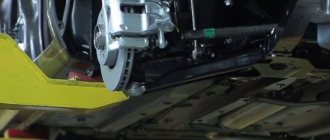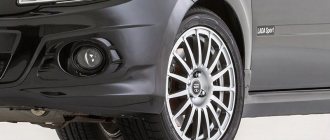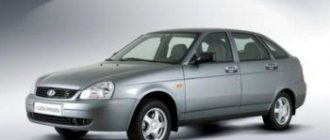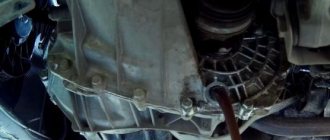How often to measure to kill rubber
Please note that pressure may change due to changes in ambient temperature.
Moreover, the process occurs equally in winter and summer. The main rule when checking is to measure it before driving, before the tires get hot. After a short trip, the wheels become very hot and the performance differs significantly from the real ones. Measurements should be taken not only after tire wear has become noticeable. The manufacturer recommends checking the inflation when you feel that the car is behaving differently.
For example, it began to throw to the sides, uncertainly when entering turns. In any operating book you will find information that a check must be carried out if temperature changes reach 10-15 degrees.
As a rule, these are the spring/autumn seasons, be careful this is a time of temperature fluctuations.
Recommendations for tire use
Recommendations for using tires on a Lada Vesta car are, in principle, no different from other car brands. It is strictly not recommended to travel for a long time on a bad road at high speed; roads with potholes and potholes can cause serious damage to the tires, which will subsequently lead to an expensive replacement. The manufacturer also advises that after some time the rear tires be placed on the front axle, and the front tires, in turn, are recommended to be placed on the rear axle. This will help prevent uneven tire wear and make them last longer.
Low profile tire pressure
This parameter, ignored by novice car enthusiasts, is very important when operating cars with any tires, and especially with low-profile ones. The required tire pressure is always indicated by the vehicle manufacturer in the operating instructions and in an accessible place on the body, for the Lada Vesta - on the B pillar on the driver's side.
- Low profile tires require increased attention to pressure, as insufficient pressure will make the wheels and suspension even more vulnerable to potholes and rocks on the road.
- As many years of experience have shown, the pressure in low-profile tires must be maintained 15% higher than that specified by the manufacturer for wheels of the recommended size.
What determines wheel inflation/pressure in R13 winter tires?
The difference in the degree of tire inflation depends on the basic parameters of the car:
- Gross vehicle weight with or without loading. With a loaded car, the wheels are pushed through more than with an empty trunk and driver.
- Cylinder dimensions. Tire cavity capacity is of primary importance. For example, the pressure in winter tires R13 VAZ 2106 and R 16 on Vesta will differ by an average of 0.4 BAR.
- Speed index. At high speeds and driving on smooth asphalt, an improved free run is required. At the same time, for off-road modifications – this is not necessary.
Tire pressure Lada Vesta
If you don’t know what pressure is in the Lada Vesta tires, then this article will answer your question.
Please note that it is necessary to check tire pressure quite often, as this directly affects driving safety. Manufacturers also set standards for each specific car so that the driver has something to focus on.
The Lada Vesta instruction manual contains the following values:
| Vehicle modification and execution | Tire size with load capacity and speed indexes* | Wheel size | Air pressure in tires front/rear, MPa (kgf/cm2) | |||
| Rim width (inches) | Rim offset (et)**, mm | Partial load*** | Full load**** | |||
| Installed by the manufacturer | ||||||
| "sedan" version | All modifications | 185/65r15 88h 195/55r16 91h | 6j | 50 | 0,21/0,21 (2,1/2,1) | 0,2/0,22 (2,1/2,1) |
| Allowed to be installed during operation | ||||||
| "sedan" version | All modifications | 185/65R15 88T, H 195/55R16 87.91T, H | 5J, 5½J, 6J 5½J, 6J, | 50 | 0,21/0,21 (2,1/2,1) | 0,21/0,21 (2,1/2,1) |
New Lada: Is it necessary and how to close the Vesta radiator in winter: reasoning and ideas
* Speed indices: T - up to 190 km/h, H - up to 210 km/h. Load capacity indices: 88–560 kg; 91–615 kg. **Rim offset (ET) is the distance from the mating plane of the disc to the middle of the rim. *** Partial load – no more than 3 adults in the car without cargo in the trunk.
**** Full load – more than 3 adults or 3 adults and a load of 50 kg in the trunk.
Deviation from these recommendations will lead to dire consequences:
- The stability and controllability of your car will deteriorate;
- Fuel consumption will increase due to greater tire resistance;
- Tire wear will increase.
If you don’t want to memorize the table, then on the Lada Vesta the recommended tire pressure values are indicated on a special information plate, which is located on the B-pillar on the driver’s side. Just open the driver's door and find out the recommended tire pressure for the Lada Vesta.
If the pressure constantly drops, then it is necessary not only to pump up the tires, but to eliminate the source of the leak. First of all, you should check the spool; if it is working, then the problem is in the tires or wheels. You may have a puncture or a loose fit between the tire and the rim.
Note that the air pressure in tires is constantly changing, depending on the temperature of the air inside the tire. At low temperatures, air compresses and pressure drops; as temperature rises, pressure increases.
It is optimal to check the readings at an ambient temperature within 10-15 degrees Celsius and after a short period of inactivity. When driving, the tires warm up, so measuring the pressure immediately after a trip is incorrect.
what in wheels 17 radius, R16, P15
Ride comfort indicators depend 70% on the size of the wheels and the correct inflation. This car is equipped with three types of wheels, and for each version the recommended tire pressure for the Lada Vesta is different.
| Dimensions | Recommended pressure At. | |
| Front axle | Rear axle | |
| 195/65 R15 | 2.10 | 2.10 |
| 205/55 R16 | 2.10 | 2.10 |
| 205/50 R17 | 2.30 | 2.30 |
An important parameter is the actual load of the machine. The above values are relevant for 4 adults in the car. If there is an additional load of about 100 kg inside the trunk. 0.1-0.2 units should be added to the nominal values. The company insists on timely monitoring of correct tire inflation. In the absence of proper care, a decrease in actual indicators by more than 15% from the standard, such negative effects may occur.
- Accelerated wear of the tread.
- Reduced steering sensitivity.
- Increased braking distance.
- Increased fuel consumption.
- The likelihood of hydroplaning on wet asphalt increases.
To facilitate control, a TPMS system is installed on board the machine, which automatically measures tire inflation in real time. Thus, it is almost impossible to “mess up” the release wheel.
Tire pressure Lada Vesta SW
The station wagon version of the car does not require a unique approach to inflating the wheels. The same indicators are relevant here as for ordinary Vesta. However, the owners of the model, based on practical experience, recommend slightly adjusting the indicators. It is better to present all information in a table.
| Wheel size | Pressure at minimum load | Pressure at maximum load | ||
| Before | Back | Before | Back | |
| R15 | 2,10 | 2,10 | 2,10 | 2,20 |
| R16 | 2,10 | 2,10 | 2,10 | 2,20 |
| R17 | 2,30 | 2,30 | 2,40 | 2,40 |
Vesta sedan tire pressure
The sedan version is supplied to the market with P15 or P16 wheels. The optimal pressure inside the tires is the same as for a station wagon. The only exception is recommendations from car owners. For unpaved roads or bumpy asphalt sections, users are of the opinion that when the indicator decreases by 0.2 At, the vehicle behaves more comfortably - the sensitivity of the suspension improves, and bumps are felt less. If the buyer actively drives the car. On the contrary, it is recommended to increase the nominal thresholds by 0.2-0.3 Bar. This is argued by reducing the likelihood of puncture or damage to the wheel rims. Also, tight tires grip hard surfaces better and improve rolling performance.
Tire pressure Vesta SV Cross
The cross version differs from its predecessor with more aggressive body kits and reinforced suspension. However, the changes did not affect the wheels of the car. Wheels with a radius of 15, 16 and 17 inches are also relevant. Actually, the same as the recommended tire pressure. The only exception is driving on unpaved roads - the company insists on increasing the figure by 0.2 At for the front and rear axles, respectively. Motorists insist that, if necessary, the air volume can be bleed by 10% to improve comfortable performance. But here the on-board TPMS system is activated. If the gap between actual and reference is too large, the instrument panel display will notify the driver that a boost is needed.
Vesta tire pressure in winter and summer
During seasons of critical ambient temperatures, it is necessary to check the pressure inside the tires at least 3 times a month. This is argued by the fact that when the temperature increases or decreases, the air changes volume.
For example, a situation is simulated: a car is moving at +40 °C on a highway. At the same time, under the influence of heat and friction, the tires heat up, and the compression of the air inside increases. Thus, diagnostics must be performed every 350-400 km, and the indicators must be equalized to the standard values (usually fluctuations are no more than 0.3 BAR).
In winter, on the contrary, the temperature drops, the on-board panel may display the following sign:
This is normal TPMS processing. With this icon, the car says that you need to pump up the tires to the specified level. Usually the difference with the standard is no more than 0.3 At.
Hub hole diameter (d)
Some manufacturers produce wheels with an oversized hole diameter for the hub - this circumstance allows them to be used using special inserts - centering rings on many car models. Therefore, a larger hole diameter for the hub is an easily solvable problem, in contrast to the opposite situation, when the hole is small.
And yet, there is a common situation when bolted fastening seems sufficient to the car enthusiast, and the use of centering rings is neglected. In this case, at speeds above 100 km/h, wheel runout begins, which can be difficult to diagnose, and pointless balancing costs follow.
How many atmospheres to pump the wheels on the Lada Vesta Cross - instructions
The factory recommendation for Vesta Cross indicates from 2.2 to 2.4 “atmospheres”, this also depends on driving style. The size plays a role, considering that the manufacturer installs R17 wheels and size 205/50.
New Lada: Lada Kalina since 2004 Operation, maintenance and repair manual
Some people want a higher, wider tire, so they “play” with the inflation level as they want. But, you need to take into account all the features, what the load is, the diameter, the larger the diameter, the smaller the height.
It is generally accepted that for the Cross version the average values range from 2.2 to 2.4 atmospheres.
Features of choosing a tread
First of all, here you need to start from the operating features of the vehicle. Low-profile tires are also suitable for urban conditions. If you plan to drive on dirt roads or off-road, then you will have to take higher tires. In addition, the noise level of the tires should also be taken into account. To make the ride more comfortable, you should pay attention to soft tires.
Based on the type of pattern, there are four types of protectors:
- symmetrical directional. The best option if you plan to drive at high speeds. At the same time, the models are resistant to aquaplaning. This pattern is well suited for high-quality drainage of water upon contact. The main disadvantage is high noise;
- symmetrical non-directional. A universal option that maintains an optimal balance between efficiency and comfort. Perhaps the water drainage rates here are not the highest, but the tires are quite good for slow water. At the same time, it will be comfortable to drive both on gravel and on the highway;
- asymmetrical non-directional. The outer part is characterized by increased rigidity, while the inner element is designed for improved drainage. The center of the rubber is designed in such a way as to increase directional stability. The disadvantage comes down to poor absorption of vibration vibrations due to the rigid center and external element;
- asymmetrical directional. Such models are the most difficult to come across, since they are practically not produced now. The elements were produced in order to smoothly distribute the load over the entire surface of the tires, as well as ensure the highest quality drainage. At the same time, car owners had to carry two spare tires with them, which led to a decrease in demand for this option.
It will also be interesting to read: Volvo XC90: technical specifications
It is worth noting that there is no ideal option here; each type of tire has its own advantages and disadvantages, so the choice must be made based on the driving style, as well as the operating conditions of the vehicle.
What non-standard sizes can be supplied?
In addition to the standard wheels listed above, you can install tires of non-standard diameter on your Lada Vesta. When choosing such solutions, you should definitely adhere to a number of recommendations:
- when using rubber with a diameter of 15 inches, the tire composition must have increased strength - since the car will have greater inertia when cornering;
- for aggressive, fast driving - wheels with a diameter of 17 inches are best suited;
- Summer tires are best equipped with wheels with a diameter of 16 inches - such wheels can be equipped with tires with a sole width of 185 to 195 mm and a profile height of 55-60 mm.
Before installing and starting to use tires of non-standard sizes, the driver should “try on” them. Often, when the wheel width or profile height increases, the tread begins to touch the plastic fender liner.
As a result, the fender liner itself may be broken, and the protector begins to quickly wear down on the plastic surface. Wheels that are too large often damage mudguards and the body.
The appearance of cracks and chips in the paintwork causes serious trouble.
Unsuitability of disks of other models of the Lada line
Wheel rims of size 185/55/R15 from the AvtoVAZ Grant, Priora and Kalina models cannot be installed on the Lada Vesta, even though at first glance they seem suitable. The diameter of the hole for the wheel hub of these cars is 58.5 mm, that is, 1.6 mm less.
But, even if this hole is bored on a lathe to the required size, the bolt pattern (PCD) of these products is 4x98, not 4x100, and 3 of the four mounting bolts will not be centered relative to the mounting holes, accordingly, the disk will not be aligned with the hub, and its rotation will be accompanied by beating.
Lada Vesta B/C 2021 1.8i
Generation: B/C Engine: I4, Gasoline Power: 124 hp (91 kW)
Wheel bolt pattern parameters
| PCD (number of holes x circle diameter) | 4×100 mm |
| Center Hole Diameter (DIA) | 60.1 mm |
| Fasteners | M12 x 1.5 |
| Type of fastener | Bolt |
| Tires | Discs | PCD | Dia | Pressure |
| 185/65 R15 88H Factory kit | 6Jx15 ET50 | 4×100 | 60.1 | 2.1 |
| 185/65 R15 88T Factory kit | 6Jx15 ET50 | 4×100 | 60.1 | 2.1 |
| 195/55 R16 91H Factory kit | 6Jx16ET50 | 4×100 | 60.1 | 2.1 |
| 205/55 R16 92H Tuning | 6.5Jx16 ET48 | 4×100 | 60.1 | 2.3 |
| 205/50 R17 91H Tuning | 6.5Jx17 ET48 | 4×100 | 60.1 | 2.3 |
| 215/45 R17 89V Tuning | 7Jx17 ET45 | 4×100 | 60.1 | 2.5 |
What wheel sizes does the manufacturer recommend to install?
The Lada Vesta B/C 2021 1.8i is equipped as standard with 6Jx15 ET50 wheel rims assembled with 185/65 R15 88H tires. Where:
- 6J - rim width in inches;
- 15″ — tire diameter in inches;
- ET50 - disc offset in millimeters.
The vehicle tire marking 185/65 R15 is deciphered as follows:
- 185 — profile width (cross section of the tire) in millimeters;
- 65 — profile height as a percentage of its width;
- R - radial cord winding;
- 15 is the tire diameter in inches.
Standard tire pressure monitoring system for Lada vesta
At the moment, this system is available - it is installed on export versions of the Lada family: Vesta, XRay, Kalina, Granta. It’s hard to say when the option will appear on Lada models intended for Russia; the fact that the option is available is encouraging. Perhaps soon the “gadgets” will be available here too.
Taking into account the equipment of export vehicles, their “tidy” is also different, because this is where information from the sensors is sent. In general, the TPMS tire pressure monitoring system is represented by four built-in sensors in the wheel valves. TPMS sensors regularly measure and send data to the dashboard, informing the driver.











